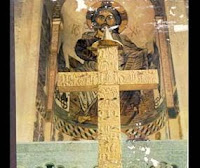Svetitskhoveli Cathedral is a Georgian Orthodox cathedral located in the historical town of Mtskheta, Georgia, 20 km or 12.5 miles northwest of the nation's capital of Tbilisi. The detail of Svetitskhoveli Cathedral is explained in world tour guides below. Svetitskhoveli known as the burial site of Christs mantle, has long been the principal Georgian church and remains one of the most venerated places of worship to this day. It presently functions as the seat of the archbishop of Mtskheta and Tbilisi, who is at the same time Catholicos-Patriarch of All Georgia.

The current cathedral was built in the 11th century by the Georgian architect Arsakisdze, though the site itself is even older dating back to the early 4th century and is surrounded by a number of legends associated primarily with the early Christian traditions. It is the second largest church building in the country, after the recently consecrated Tbilisi Sameba Cathedral, and is listed as an UNESCO World Heritage Site along with other historical monuments of Mtskheta. The original church was built in IV century A.D. during the reign of Mirian III of Kartli in Iberia. St. Nino is said to have chosen the confluence of the Mtkvari in Kura and Aragvi rivers as the place of the first Georgian Church.
Svetitskhoveli Cathedral, originally built in the 4th century, has been damaged several times during history, notably by the invasions of Arabs, Persians, and Timur and latterly during Russian subjugation and the Soviet period. The building has also been damaged by earthquakes. During the restoration of 1970-71 which was presided over by V. Tsintsadze, the base of the basilica built in the late 5th century by King Vakhtang Gorgasali after St. Ninos original church was found. During the early years of Georgian church building, the basilica was the dominant type of the Georgian church architecture before the cross-dome style emerged.
In the 11th century, the present Svetitskhoveli Cathedral was rebuilt from 1010 to 1029 in the Cross-Dome style by the architect Arsukidze, at the invitation of the Catholicon Melkisedek of Georgia. The king of Georgia for that time was Giorgi II or George II. The cathedral is surrounded by a defensive wall, built of stone and brick during the reign of King Erekle II or Heraclius in 1787. The top storey was designed for military purposes and has gun emplacements.
The entrance to the Cathedral from the wall is located to the south. The wall has eight towers six of them are cylindrical and two of them are square. Archaeological expeditions in 1963 found the house of Patriarch of the 11th century at the southern part of the wall. Inside the church yard, the remains of the two-story castle of Patriarch Anton II were found.
The base of the three-storey basilica, supposed to have been built by Vakhtang Gorgasali after St.Ninos original church, has been found by archaeologists during the restoration of 1970-71. The architecture of the present Svetitskhoveli Cathedral, which dates from around 1020, is based on the cross-dome style of church architecture, which emerged in Georgia in the early Middle Ages and became the principle style after the political unification of Georgia by Bagrat III 978-1014. The characteristic of this style is that the dome is placed across all four sides of church.
The basic stone used for the Cathedral is a sandy yellow with trimmings, while around the apse window a red stone is used. The green stone used in the drum of the cupola is from the 17th century. The curved blind arcading throughout is unaltered from the 11th century. A large window occupies most of the western top side of the church. The decoration shows the Christ sitting and two angels at the both sides. The original sculpture on the wall has not survived, but was restored several times, most recently in the 19th century.


The interior walls are painted with frescoes, most of which have not survived in their original state. The walls are decorated with many Christian Orthodox icons, most of which are not original. The large figure of Jesus at the altar was painted by Russian artist in the 19th century. The majority of the icons here date to the 20th century. Two bull heads are incorporated into the east facade, surviving from the fifth-century church, and testimony of the folk influence on Christian iconography in that early period.
Svetitskhoveli was not only the site of the coronation of the Georgian kings but also served as their burial place. Ten are known to have been buried here, although only six tombs have been found, all before the altar. The tomb of King Vakhtang Gorgasali can be identified by his the small candle fortress standing before it. King Erekle II's tomb is identifiable by the sword and shield upon it. His son, George XII was the last king of Georgia and his marble tomb is next to his father. Also in front of the altar are tombs of David VI, George VIII, Luarsab I and various members of the Bagrationi royal family including Tamar, the first wife of George XI, whose epitaph dating from 1684 is written both in Georgian and Arabic script.







No comments:
Post a Comment